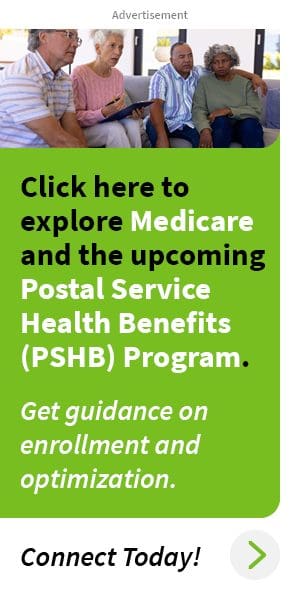Key Takeaways
-
If you’re eligible for Medicare and enrolled in a PSHB plan in 2025, skipping Medicare Part B could result in coverage disruptions and permanently higher costs.
-
PSHB and Medicare Part B are now intertwined, and understanding how they coordinate will help you avoid penalties and receive full benefits.
The Changing Relationship Between PSHB and Medicare
Starting in 2025, the Postal Service Health Benefits (PSHB) Program officially replaced the Federal Employees Health Benefits (FEHB) program for Postal Service employees and retirees. Along with this transition, the role of Medicare—especially Part B—has become more central than ever for annuitants and their eligible family members.
You may assume that PSHB is a standalone program, but in reality, your choices about Medicare Part B can directly affect the quality, cost, and even continuity of your PSHB coverage. Understanding how these two systems interact is essential if you want to avoid long-term penalties or loss of benefits.
Medicare Part B Basics in 2025
Medicare Part B covers outpatient services like doctor visits, preventive care, lab tests, and durable medical equipment. In 2025:
-
The standard Part B monthly premium is $185.
-
The annual deductible is $257.
-
Higher-income enrollees pay an additional amount known as IRMAA (Income-Related Monthly Adjustment Amount).
Part B is optional in theory, but for many under the PSHB umbrella, it no longer functions like a choice.
PSHB’s Medicare Part B Requirement: Who Must Enroll
As of January 1, 2025, Medicare-eligible Postal Service annuitants and their family members are required to enroll in Medicare Part B to maintain full PSHB coverage. However, not everyone is subject to this requirement. The following individuals are exempt:
-
Retirees who were already retired as of January 1, 2025, and not enrolled in Medicare Part B.
-
Active USPS employees who were age 64 or older on January 1, 2025.
-
Individuals who reside outside the U.S. or its territories.
-
Individuals who qualify for coverage through the VA or Indian Health Services.
If none of these exceptions apply to you, you must enroll in Medicare Part B once eligible, typically around age 65. Failing to do so may lead to serious consequences.
What Happens If You Skip Medicare Part B
Choosing not to enroll in Medicare Part B, despite being required, may lead to:
-
Loss of drug coverage: PSHB plans integrate with Medicare Part D through an EGWP (Employer Group Waiver Plan). If you opt out of Part B, your Part D benefits may also be impacted.
-
Limited cost-sharing benefits: Many PSHB plans reduce or waive deductibles, coinsurance, and copayments for those enrolled in Part B. Without Part B, you’ll lose those savings.
-
Coverage disruptions: Some PSHB plans are structured with the assumption that Medicare is primary. If you don’t have Part B, your claims may be delayed, denied, or result in higher out-of-pocket costs.
-
Permanent penalties: If you delay enrollment without qualifying for a Special Enrollment Period, Medicare will add a 10% surcharge to your Part B premium for every 12-month period you were eligible but unenrolled. This penalty lasts for life.
Coordination of Benefits: Who Pays First
When you’re enrolled in both PSHB and Medicare Part B, Medicare generally becomes your primary payer. This means:
-
Medicare Part B pays first for outpatient care.
-
Your PSHB plan pays second, often covering what Medicare doesn’t.
This coordination significantly reduces your out-of-pocket expenses. However, if you don’t have Part B, your PSHB plan becomes the sole payer, and you’re responsible for a larger share of costs.
PSHB Incentives for Having Medicare Part B
To encourage enrollment, many PSHB plans offer added benefits to those with Part B:
-
Waived deductibles
-
Lower copayments and coinsurance
-
Access to additional providers
-
Enhanced care coordination
-
Part B premium reimbursement (in select cases)
These cost-saving features are available only when Part B enrollment is confirmed. Without it, you may face higher medical bills and more limited networks.
When and How to Enroll in Medicare Part B
Most people become eligible for Medicare at age 65. Your Initial Enrollment Period (IEP) is a 7-month window:
-
Begins 3 months before your 65th birthday month
-
Includes your birthday month
-
Ends 3 months after your birthday month
If you miss this window and don’t qualify for a Special Enrollment Period (SEP) based on current employment, you’ll have to wait for the General Enrollment Period (January 1 – March 31), and coverage won’t begin until July 1.
Delaying enrollment without qualifying for an SEP leads to lifelong late penalties. Since the PSHB requirement is based on your Medicare eligibility, timing is crucial.
The Employer Group Waiver Plan (EGWP) Connection
PSHB plans integrate Part D drug coverage through an EGWP. If you are enrolled in both PSHB and Medicare Parts A and B, you’re automatically enrolled in this enhanced drug coverage. Benefits include:
-
Lower copayments on medications
-
Broader pharmacy networks
-
Insulin capped at $35/month
-
Annual out-of-pocket drug maximum of $2,000
However, if you choose not to enroll in Part B, you may become ineligible for the EGWP, meaning higher drug costs and potential coverage gaps.
Financial Risks of Skipping Part B
If you’re relying on PSHB alone without enrolling in Medicare Part B, your healthcare costs could be substantially higher due to:
-
No secondary coverage to pick up Medicare-eligible expenses
-
No access to waived deductibles and cost-sharing reductions
-
Exposure to full outpatient costs
-
Risk of lifetime late enrollment penalties
Over time, these extra costs can exceed the standard Part B premium, making it a financially risky decision to skip enrollment.
What if You’re Still Working at 65?
If you are still actively working for USPS at age 65, you may be able to delay Part B without penalty as long as you’re enrolled in a PSHB plan through employment. Once you retire, you’ll have an 8-month Special Enrollment Period to sign up for Part B without penalty.
However, the moment you separate from employment, the countdown begins. Failing to act during the SEP could result in higher premiums and disrupted coverage.
Clarifying Your Next Steps
If you’re approaching Medicare eligibility, here’s what you should do:
-
Confirm your eligibility for Medicare Part B.
-
Review whether you fall under any PSHB exemptions.
-
Understand the financial impact of delaying or avoiding Part B.
-
Contact Social Security to begin the Medicare enrollment process.
-
Verify how your specific PSHB plan coordinates with Medicare.
It’s also wise to revisit your plan documents or speak to a licensed agent listed on the website who understands the PSHB-Medicare relationship and can help you avoid costly missteps.
Why It’s Not Just a Personal Choice Anymore
In the past, opting into Medicare Part B may have felt like a personal decision. In 2025, for Postal Service annuitants and their family members, it has become a structural requirement. Skipping Part B can lead to a domino effect: penalties, reduced benefits, and uncovered services.
You don’t just risk paying more. You risk losing some of the core advantages of PSHB altogether.
Think Long-Term, Act on Time
Making the decision about Medicare Part B might seem complex, but it’s one of the most important choices you’ll face if you’re covered under PSHB. This isn’t just about premiums—it’s about ensuring long-term access to coordinated, cost-effective healthcare.
If you’re uncertain, confused, or just want reassurance, now is the time to act. Speak to a licensed agent listed on this website to receive professional advice tailored to your situation.










